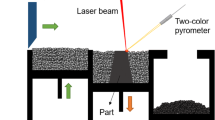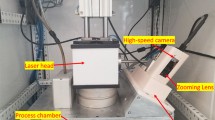Abstract
In laser powder bed fusion (LPBF), it is common practice to select process parameters to achieve high density parts starting from simple geometries such as cubes or cylinders. However, additive manufacturing is usually adopted to produce very complex geometries, where parameters should be tuned locally, depending on the local features to be processed. In fact, geometrical features, such as overhangs, acute corners, and thin walls may lead to over- or under-heating conditions, which may result in geometrical inaccuracy, high roughness, volumetric errors (i.e., porosity) or even job failure due to surface collapse. This work proposes a layer-wise control strategy to improve the geometrical precision of overhanging regions using a coaxial melt pool monitoring system. The melt-pool images acquired at each layer are used in a control-loop to adapt the process parameters locally at the next layer in order to minimize surface defects. In particular, the laser duty cycle is used as a controllable parameter to correct the energy density. This work presents the main architecture of the proposed approach, the control strategy and the experimental procedure that need to be applied to design the control parameters. The layer-wise control strategy was tested on AISI 316L stainless steel using an open LPFB platform. The results showed that the proposed layer-wise control solution results in a constant melt pool observed via the laser heated area size starting from the second layer onward, leading to a significant improvement in the geometrical accuracy of 5 mm-long bridge geometries.

















Similar content being viewed by others
References
Grasso M, Colosimo BM (2017) Process defects and in situ monitoring methods in metal powder bed fusion: a review. Meas Sci Technol 28(4):044005. https://doi.org/10.1088/1361-6501/aa5c4f
Tapia G, Elwany A (2014) A review on process monitoring and control in metal-based additive manufacturing. J Manuf Sci Eng Trans ASME 136(6):060801. https://doi.org/10.1115/1.4028540
Pavlov M, Doubenskaia M, Smurov I (2010) Pyrometric analysis of thermal processes in SLM technology. Phys Procedia 5(PART 2):523–531
Lott P, Schleifenbaum H, Meiners W et al (2011) Design of an optical system for the in situ process monitoring of selective laser melting (SLM). Phys Procedia 12(PART 1):683–690
Eschner N, Weiser L, Häfner B et al (2018) Development of an acoustic process monitoring system for selective laser melting (SLM). Solid Free Fabr Symp 2017:2097–2117
Fisher BA, Lane B, Yeung H et al (2018) Toward determining melt pool quality metrics via coaxial monitoring in laser powder bed fusion. Manuf Lett 15:119–121
Colosimo BM, Grossi E, Caltanissetta F et al (2020) Penelope: a novel prototype for in situ defect removal in LPBF. OM 72(3):1332–1339
Caltanissetta F, Grasso M, Petrò S et al (2018) Characterization of in-situ measurements based on layerwise imaging in laser powder bed fusion. Addit Manuf 24(8):183–199
Kanko JA, Sibley AP, Fraser JM (2016) In situ morphology-based defect detection of selective laser melting through inline coherent imaging. J Mater Process Technol 231:488–500
Smith RJ, Hirsch M, Patel R et al (2016) Spatially resolved acoustic spectroscopy for selective laser melting. J Mater Process Technol 236:93–102
Martin AA et al (2019) Dynamics of pore formation during laser powder bed fusion additive manufacturing. Nat Commun 10(1):1–10
Paulson NH, Gould B, Wolff SJ et al (2020) Correlations between thermal history and keyhole porosity in laser powder bed fusion. Addit Manuf 34:101213. https://doi.org/10.1016/j.addma.2020.101213
Grasso M, Laguzza V, Semeraro Q et al (2016) In-process monitoring of selective laser melting: spatial detection of defects via image data analysis. J Manuf Sci Eng 139(5):051001. https://doi.org/10.1115/1.4034715
Finazzi V, Demir AG, Biffi CA et al (2019) Design rules for producing cardiovascular stents by selective laser melting: geometrical constraints and opportunities. Procedia Struct Integr 15:16–23
Khairallah SA, Martin AA, Lee JRI et al (2020) Controlling interdependent meso-nanosecond dynamics and defect generation in metal 3D printing. Science 368(6491):660–665
Caprio L, Demir AG, Previtali B (2018) Influence of pulsed and continuous wave emission on melting efficiency in selective laser melting. J Mater Process Tech 266:429–441
Demir AG, Previtali B (2017) Additive manufacturing of cardiovascular CoCr stents by selective laser melting. Mater Des 119:338–350
Demir AG, Colombo P, Previtali B (2017) From pulsed to continuous wave emission in SLM with contemporary fiber laser sources: effect of temporal and spatial pulse overlap in part quality. Int J Adv Manuf Technol 91(5/8):2701–2714
Demir AG, Mazzoleni L, Caprio L et al (2019) Complementary use of pulsed and continuous wave emission modes to stabilize melt pool geometry in laser powder bed fusion. Opt Laser Technol 113:15–26
Hofman JT, Pathiraj B, Van Dijk J et al (2012) A camera based feedback control strategy for the laser cladding process. J Mater Process Tech 212(11):2455–2462
Song L, Mazumder J (2011) Feedback control of melt pool temperature during laser cladding process. IEEE Trans Control Syst Technol 19(6):1349–1356
Duflou JR, Sichani EF, De Keuster J et al (2009) Developement of a real time monitoring and adaptive control for laser flame cutting. J Laser Appl 2009:527–536
Postma S, Aarts RGKM, Meijer J et al (2018) Penetration control in laser welding of sheet metal using optical sensors. Proc of ICALEO 2001:1083–1092
Kempen KJP, Vrancken B, Thijs L et al (2013) Lowering thermal gradients in selective laser melting by pre-heating the baseplate. Solid Free Fabr Symp Proc 24:131–139
Demir AG, Previtali B (2017) Investigation of remelting and preheating in SLM of 18Ni300 maraging steel as corrective and preventive measures for porosity reduction. Int J Adv Manuf Technol 93(5):2697–2709
Li Z, Xu R, Zhang Z et al (2018) The influence of scan length on fabricating thin-walled components in selective laser melting. Int J Mach Tools Manuf 126:1–12
Zeng K, Pal D, Gong HJ et al (2015) Comparison of 3DSIM thermal modelling of selective laser melting using new dynamic meshing method to ANSYS. Mater Sci Technol 31(8):945–956
Bugatti M, Semeraro Q (2018) Limitations of the inherent strain method in simulating powder bed fusion processes. Addit Manuf 23:329–346
Druzgalski CL, Ashby A, Guss G et al (2020) Process optimization of complex geometries using feed forward control for laser powder bed fusion additive manufacturing. Addit Manuf 34:101169. https://doi.org/10.1016/j.addma.2020.101169
Mazzoleni L, Demir AG, Caprio L et al (2019) Real-time observation of melt pool in selective laser melting: spatial, temporal and wavelength resolution criteria. IEEE Trans Instrum Meas 69(4):1179–1190
Renken V, von Freyberg A, Schünemann K et al (2019) In-process closed-loop control for stabilising the melt pool temperature in selective laser melting. Prog Addit Manuf 4:411–421
Yeung H, Lane BM, Donmez MA et al (2018) Implementation of advanced laser control strategies for powder bed fusion systems. Procedia Manuf 26:871–879
Craeghs T, Bechmann F, Berumen S et al (2010) Feedback control of layerwise laser melting using optical sensors. Phys Proc 5(PART 2):505–514
Mercelis P, Kruth JP, Van Vaerenbergh J (2007) Feedback control of selective laser melting. Proc 15th Int Symp Electromachining, ISEM 2007, pp 421–426
Hirsch M et al (2017) Assessing the capability of in-situ nondestructive analysis during layer based additive manufacture. Addit Manuf 13:135–142
Demir AG, De Giorgi C, Previtali B (2018) Design and implementation of a multisensor coaxial monitoring system with correction strategies for selective laser melting of a maraging steel. J Manuf Sci Eng 140(4):041003. https://doi.org/10.1115/1.4038568
Lane B, Heigel J, Ricker RE et al (2020) Measurements of melt pool geometry and cooling rates of individual laser traces on IN625 bare plates. Integr Mater Manuf Innov 9(1):16–30
Pacher M, Mazzoleni L, Caprio L et al (2019) Estimation of melt pool size by complementary use of external illumination and process emission in coaxial monitoring of selective laser melting. J Laser Appl 31(2):022305. https://doi.org/10.2351/1.5096117
Mazzoleni L, Caprio L, Pacher M et al (2018) External illumination strategies for melt pool geometry monitoring in SLM. JOM 71:928–937
Adnan M, Lu Y, Jones A et al (2018) Application of the fog computing paradigm to additive manufacturing process monitoring and control. T Emerg Telecommun T 29(4):1–14
Clijsters S, Craeghs T, Buls S et al (2014) In situ quality control of the selective laser melting process using a high-speed, real-time melt pool monitoring system. Int J Adv Manuf Technol 75(5):1089–1101
Vasileska E, Demir AG, Colosimo BM et al (2020) Layer-wise control of selective laser melting by means of inline melt pool area measurements. J Laser Appl 32(2):022057. https://doi.org/10.2351/7.0000108
Hooper PA (2018) Melt pool temperature and cooling rates in laser powder bed fusion. Addit Manuf 22:548–559
Heigel JC, Lane BM (2018) Measurement of the melt pool length during single scan tracks in a commercial laser powder bed fusion process. J Manuf Sci Eng Trans ASME 140(5):051012. https://doi.org/10.1115/1.4037571
Spierings AB, Levy G (2009) Comparison of density of stainless steel 316L parts produced with selective laser melting using different powder grades. 20th Annu Int Solid Free Fabr Symp SFF, pp 342–353
Lane B, Moylan S, Whitenton EP et al (2016) Thermographic measurements of the commercial laser powder bed fusion process at NIST. Rapid Prototyp J 22(5):778–787
Sih SS, Barlow JW (2004) The prediction of the emissivity and thermal conductivity of powder beds. Part Sci Technol 22(4):427–440
Fischer P, Romano V, Weber HP et al (2003) Sintering of commercially pure titanium powder with a Nd: YAG laser source. Acta Mater 51(6):1651–1662
Phillips T, Ricker T, Fish S et al (2020) Design of a laser control system with continuously variable power and its application in additive manufacturing. Addit Manuf 34:101173. https://doi.org/10.1016/j.addma.2020.101173
Acknowledgements
The authors gratefully acknowledge Dr. Matteo Pacher for his help in the image processing phase. The Italian Ministry of Education, University and Research is acknowledged for the support provided through the Project "Department of excellence LIS4.0—lightweight and smart structures for Industry 4.0”.
Author information
Authors and Affiliations
Corresponding author
Rights and permissions
About this article
Cite this article
Vasileska, E., Demir, A.G., Colosimo, B.M. et al. A novel paradigm for feedback control in LPBF: layer-wise correction for overhang structures. Adv. Manuf. 10, 326–344 (2022). https://doi.org/10.1007/s40436-021-00379-6
Received:
Revised:
Accepted:
Published:
Issue Date:
DOI: https://doi.org/10.1007/s40436-021-00379-6




